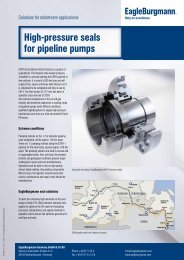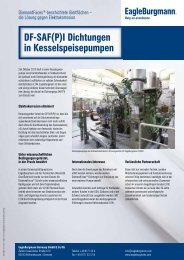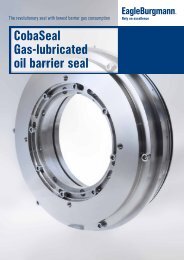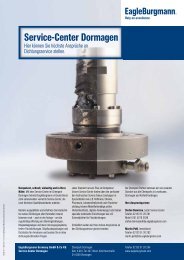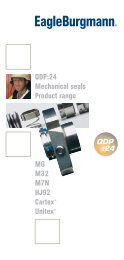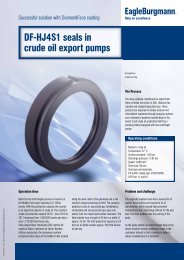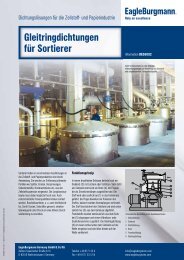Emergency Services - EagleBurgmann
Emergency Services - EagleBurgmann
Emergency Services - EagleBurgmann
Create successful ePaper yourself
Turn your PDF publications into a flip-book with our unique Google optimized e-Paper software.
Bellows<br />
Monitoring<br />
• Multi-ply Bellows<br />
• Normal 2-ply Monitoring<br />
• Redundant Ply<br />
• Monitoring Types - Passive &<br />
Active<br />
Bellows Monitoring<br />
The use of multi-ply bellows on FCCU<br />
expansion joints is widespread today.<br />
Various reasons exist for the use of<br />
multi-ply bellows, ranging from redundant<br />
ply design to simple monitoring<br />
for early warning of failure.<br />
• Multi-ply Bellows<br />
Multi-ply bellows in themselves allow<br />
the bellows designer to design for<br />
higher movements combined with high<br />
pressure and still achieve good cycle<br />
life. In laymen’s terms the thicker the<br />
bellows wall thickness the lower the<br />
cycle life for a given movement. By<br />
using two plies of a thinner material<br />
the cycle life will increase for the same<br />
movement without a dramatic drop in<br />
pressure capability. A simple two ply<br />
bellows is designed to use the strength<br />
of both plies to ensure pressure capability.<br />
Redundant ply bellows are designed<br />
so that each ply is strong enough<br />
to withstand the operating conditions<br />
even after one ply fails. These types of<br />
multi-ply designs are usually monitored<br />
to alert the user when one ply fails.<br />
• Normal 2 ply monitoring<br />
Monitoring a normal two-ply design<br />
still offers great advantages for the<br />
operator. A very small leak through<br />
the inner ply will normally not cause a<br />
catastrophic failure. The indicator will<br />
show the leak and the unit can be shut<br />
down for repairs without a total failure<br />
of the unit.<br />
• Redundant Ply<br />
Redundant ply designs offer safety and<br />
outage scheduling benefits. The intent<br />
is to enable the unit to continue to<br />
operate until the next scheduled outage<br />
even after one ply has failed. The<br />
inner ply typically fails before the outer<br />
ply. The operators can see the failure<br />
and plan for changing the unit at the<br />
next scheduled outage.<br />
Monitor Types<br />
Various monitoring devices can be<br />
used from connecting a simple pressure<br />
gauge to electronic sensing devices.<br />
This is a typical monitoring port as it<br />
protrudes through the cover. This unit<br />
was electronically monitored by the<br />
control in the refinery.<br />
Our monitors can provide a visual<br />
indicator that will reveal a ply failure<br />
that connects directly to the port and is<br />
installed before shipment.<br />
• Passive monitor<br />
Passive monitors utilize the line pressure<br />
to indicate an inner ply failure.<br />
When the inner ply fails the line pressure<br />
between the plies will activate the<br />
monitoring device. Passive monitors<br />
will only sense an inner ply failure.<br />
• Active monitor<br />
The active monitor will detect both inner<br />
and outer ply failures. A vacuum<br />
is pulled between the plies before the<br />
monitoring device is installed. If the inner<br />
ply fails, the pressure between the<br />
plies will increase to the line pressure.<br />
If the outer ply fails the vacuum will be<br />
lost.<br />
9



